If the shoe fits: Fashion prof’s research links footwear and crime
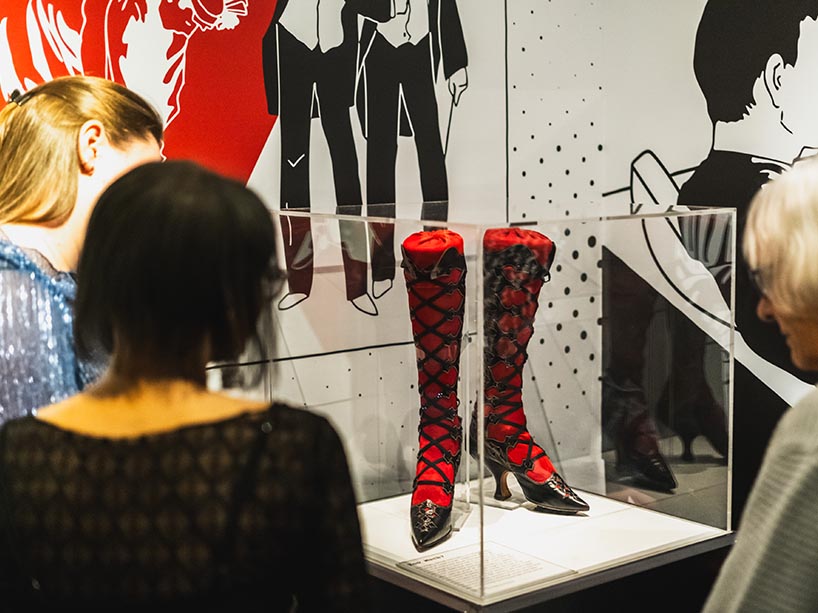
Attendees at the opening party for Exhibit A: Investigating Crime and Footwear, view an item from Poland in the 1890s. Historically, it was believed that female criminality was driven by a natural desire for fashion. These boots would have been seen as enticing by many people of that period. (Photo: Jae Yang)
Every shoe tells a story. And as the work of Toronto Metropolitan University professor Alison Matthews David shows – some shoes reveal much more than that: evidence of a crime.
Matthews David’s research, Exhibit A: Investigating Crime and Footwear, on display now at Toronto’s Bata Shoe Museum, examines the development of footwear forensics as a means of solving crime, along with the social constructions of criminality from the 19th century to today.
Curated by Matthews David alongside the museum’s director and senior curator, Elizabeth Semmelhack, the exhibition features more than 27 items from TMU’s Fashion Research Collection, and galleries in Quebec, Paris, Switzerland, the Toronto Police Museum, The Crime Museum of New Scotland Yard in London, UK and Canada’s Penitentiary Museum in Kingston, Ont.
The exhibition examines how footwear and clothing play a role in cultural ideas of criminality informed by assumptions and bias, and highlights the role of footwear in crime, policing and the judiciary system.
Sherlock Holmes, dad’s work with homicide squad
Inspiration to research the connection between crime and footwear came to Matthews David in a variety of ways.
Growing up, she had an affinity for Sherlock Holmes and murder mysteries.
Her dad’s work, too, fed her intrigue. He worked as a computer programmer for the Toronto police homicide squad, and as Matthews David followed the cases he was working on, her fascination with crime grew.
Years later, as Matthews David pursued a career in fashion history, she learned how detectives used forensic techniques to find arsenic in green coloured dresses.
It planted the seed that a link existed between fashion and the detection of poisonings.
“Plus, I think I was just taken by that image of the detective in a trench coat and a fedora - who always had a magnifying glass in hand, and always seemed to be tracking footsteps,” she said.
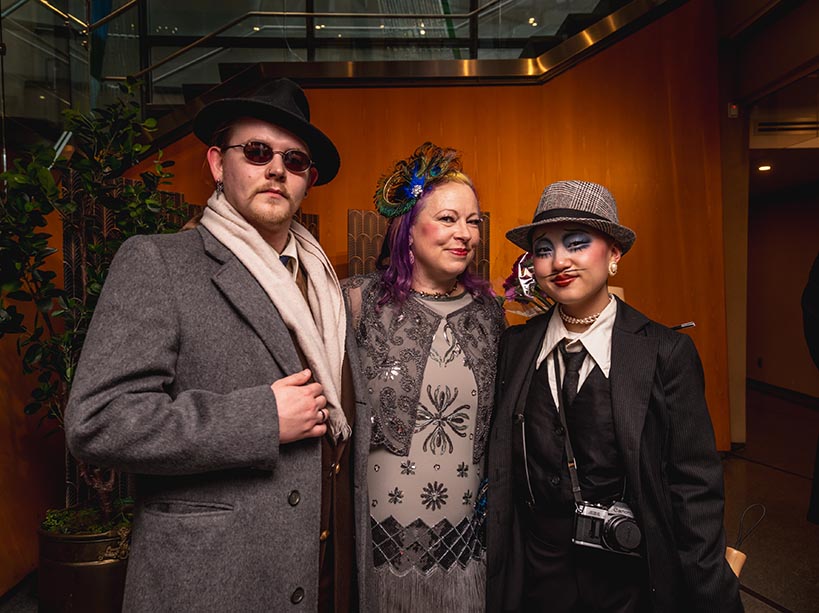
After learning about her footwear and crime exhibit, the FBI invited TMU professor Alison Matthews David, centre, to meet with the bureau’s footwear expert this summer. Above, she’s joined by MA Fashion student Mia Yaguchi-Chow, right, and their partner at the exhibit opening event. (Photo: Jae Yang)
Footprints determining life or death
The role of footprints in studying crime goes back hundreds of years. Before fingerprinting became common in the early 20th century, investigators like Sherlock Holmes relied heavily on footprints to identify suspects, Matthews David explained. Mastering this technique was crucial since it could often mean the difference between life and death in an age of capital punishment.
Matthews David says there are many ways footwear can give clues about a crime. Years ago, a key piece of evidence was the presence of nails in the soles of working-class shoes. Unlike the rubber treads on modern shoes, these nails, often called hobnails, were hammered in by individual workers in specific patterns for grip while walking through mud, snow, or performing manual labour. This unique pattern could link a footprint to a specific boot.
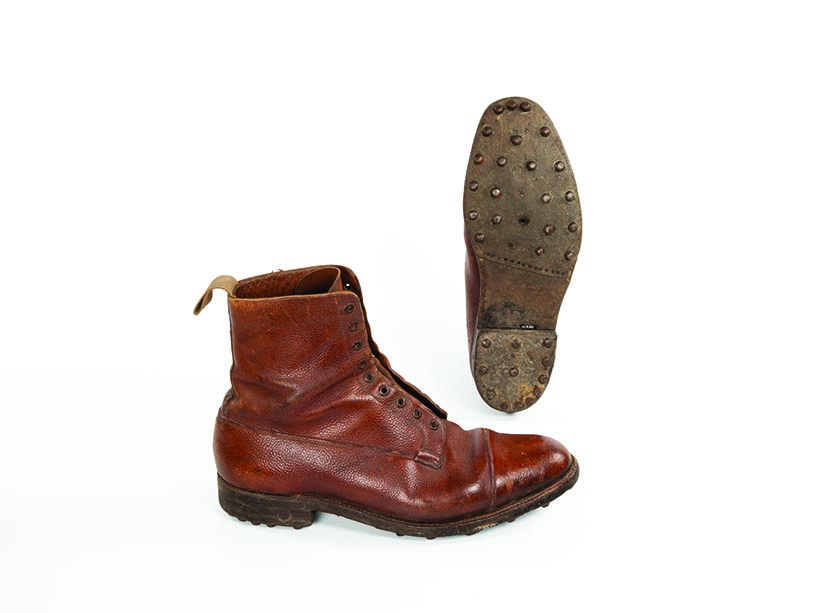
Above, “hobnail boots” worn by working class men in the 19th and early 20th century, offered clues to investigators since each shoemaker and region had distinctive nails and patterns. (Photo: Courtesy of Bata Shoe Museum)
For crimes happening in rural areas, like livestock theft, muddy trails left behind by the perpetrator's shoes could be crucial. In cases of physical violence, footprints or sock prints in blood might be found. Shoes could also collect and deposit dust, paint, or other substances.
Even today, Matthews David also says shoes and footprints can reveal traits of the person wearing them, such as whether a person pronates or supinates, their weight and height, and that the type of shoe can be telling.
“Shoes show what environments a person has passed through, what social class they might belong to, what gender they might be,” she said.
Ability to ‘sneak’ away
Matthews David reminds us too that even the term “sneakers” speaks to the idea that certain types of shoes allow a person to move undetected.
“It’s that ability to sneak away,” she said. “Most people’s footwear would make a lot of noise when they walked, so to have rubber soles in the 19th century, it wasn’t just for athletic or leisure purposes, there were ‘sneak thieves’ who could move silently,” she explained.
They were also advantageous to investigators.
“Even detectives could be heard in regulation police boots, so they started wearing rubber-soled shoes, leading to the term ‘gumshoe detective’,” she explained.
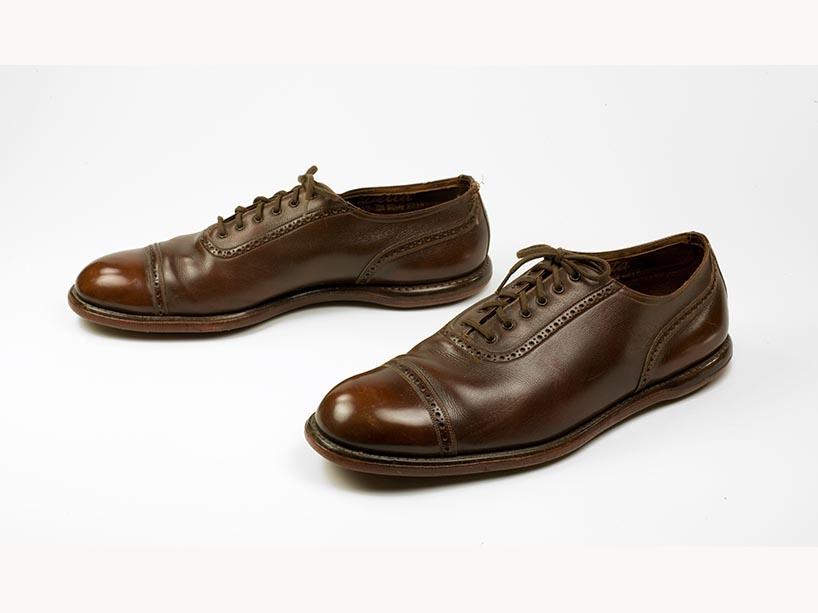
In England in the 1930s, butlers were prized for their ability to inconspicuously serve their employers by wearing shoes that allowed them to move silently through the house. It’s also why they were often cast as suspects when a crime was committed. (Photo: Courtesy of Bata Shoe Museum)
Did the butler do it?
As the opening exhibit item – a pair of butler shoes – demonstrates, investigators weren’t the only ones wearing “sneaky” footwear on the job.
“Today, most of us don't have butlers, but there's that famous question in crime fiction: "Did the butler do it?" Matthews David said.
The trope, she explains, which was common in Agatha Christie's golden age of crime stories, stems from the butler's access to all the keys, the wine cellar, and valuable items in the household.
The butler, Matthews David said, was expected not to make noise as a servant. His shoes allowed him to walk silently. So, when a crime was committed, the butler was often a prime suspect in fiction. This notion also reflects class status, as it influenced whom people would suspect of a crime, she noted.
Flannel foot burglar
Matthews David’s exhibit also features the “Flannel foot” burglar, from England in the 1930s. For 25 years, robber Henry Edward Vickers used strips of flannel around his feet to obscure his footprints while robbing peoples’ homes – then fleeing by bike. The flannel that was used on his feet appears in Matthews David’s exhibit and still has evidence tags from the Scotland Yard police. It’s the first time the item has been on public exhibition and outside of the UK.
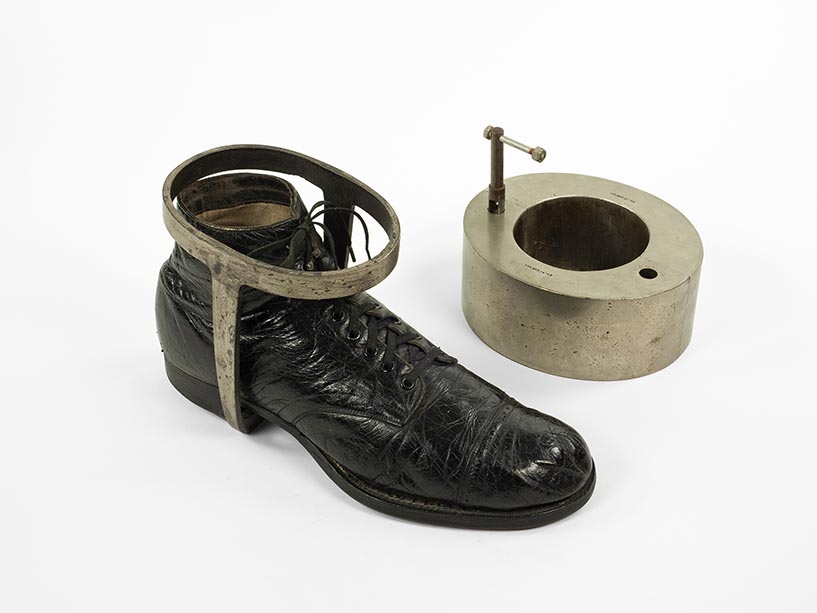
Oregon boots were designed and patented by a prison warden in 1866. They could weigh up to 28 pounds and prevent an escape. They could also permanently disable wearers, with many limping for the rest of their lives. (Photo: Courtesy of Bata Shoe Museum)
Biggest challenge
Matthews David said the most difficult aspect of putting the exhibit together was recognizing sensitivity around many of the items, keeping in mind the position of both her and Semmelhack as white, female and middle class curators.
“We had to ask ourselves, ‘How do we tell these stories with objects that have very fraught histories?’” she said.
For instance, part of the collection features the Oregon Boot – a heavy leather boot with metal shackle that was put around a prisoner’s leg.
“When you think about the histories of crime and criminality, who was incarcerated, who was suspected – and how white-collar crime is not, as we are finding out with Trump – it's a whole different set of parameters depending on your social status. Your race, gender, social class and privilege all play a role,” she said.
“It was hard to figure out how to tell those stories, keeping in mind how they might be received by different audiences,” she said.
Exhibit to prompt questions
Matthews David says she hopes the exhibit will encourage people to think more deeply about what criminality means, how problematic the justice system and law enforcement can be, and to ask important questions.
It’s in part why they conclude their exhibit with a quote from Sherlock Holmes: “There is nothing more deceptive than an obvious fact.”
“You know in an age of false news and AI generation, I think questioning how we see reality and truth is an important thing,” she said.
Exhibit A: Investigating Crime and Footwear opened on April 18 and will run for 18 months.
Related:





